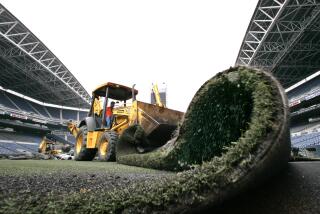Sun, surf, smog
JUST IN CASE you missed it, last week was National Air Quality Control Week. That explains why the American Lung Assn. released its new study announcing that Los Angeles is still the smog capitol of the United States.
Not exactly a man-bites-dog story, but some Angelenos may recall that we were actually stripped of that title a few years ago when the Environmental Protection Agency crowned Houston the new pollution king. For me, an asthmatic and no friend to smog, that moment was bittersweet. Because more than anything else, smog is L.A.’s classic signifier. Just as the cult of noir flourished in the underbelly of the city of sunshine, smog has long been the ubiquitous sign that there is trouble in paradise. Who and what would we be without it?
If the great weather is our raison d’etre and space -- and, by extension, cars -- our birthright, then for the last 60-odd years, smog has been the penance for all that and more. L.A. was the first city to combine plentiful sunshine with enormous numbers of cars traveling long distances every day, which happens to be a good recipe for smog.
As for doing penance: We’re the only great city in the world that has had to apologize for its very existence. You know the drill: We’re in the desert; we stole the water; we shouldn’t really exist. But that sort of environmentalist hand-wringing doesn’t just occur in the pages of newspapers and academic tracts, it’s part of the everyday morality tale of living in Southern California.
Particularly if you grew up here in the 1960s and 1970s, when the smog was at all-time highs, you’re sensitive to the rhythm of pollution, the worst seasons, the worst times of the day and the wind conditions and temperatures that make the toxic haze wax or wane. Smog is the limit to our fun in the sun.
I remember playing whiffle ball as a boy with my cousin, Marcos, when my aunt called us in because of the pollution. Then there were restless days in junior high when we couldn’t go out for phys ed. When I got older, I learned to anticipate the end of idyllic, clear blue skies. I know that, after three gorgeous hot dry days with no wind, the smog will return with a vengeance.
Not only has smog been the thunder cloud in the land of silver linings, it’s embarrassing. I was in high school when Britain’s Prince Philip, speaking in his capacity as president of the International Equestrian Federation, publicly fretted over the effect L.A.’s smog would have on horses in the 1984 Olympics. Ouch.
And the shame of smog worked its way into our social hierarchy. In Glendale, where I grew up, I knew that we had worse air than they did in, say, West L.A., but we could, thank goodness, say it wasn’t as bad as it was in Claremont. Meanwhile, Claremonters could feel superior to long-suffering San Bernardinans.
Perhaps in an attempt to grapple with their shame, Angelenos have sometimes tried to look for the hidden benefits of smog. Like the character in the movie “Get Shorty,” we routinely credit the bad air for our wonderful sunsets. A decade ago, a UCLA-trained environmental engineer released a study revealing that, although L.A.’s smog clearly has adverse health effects, it also dramatically reduces the intensity of ultraviolet rays.
In 1971, one non-Angeleno economist did a brief cost-benefit analysis of the elimination of smog here. Yes, it would be aesthetically pleasing as well as beneficial to our health, he concluded. It could even lower the prices of some goods. But the eradication of smog, he argued, could also make L.A. a more attractive place to live, thereby encouraging even more migrants, which would only further raise home prices and rents and add to congestion, noise and litter.
I don’t love smog, but I admit to appreciating its cultural role in our lives. It was a recurring character in Raymond Chandler novels. “The weather was hot and sticky and the acid sting of the smog had crept as far west as Beverly Hills,” he wrote in “The Long Goodbye.” It was a menacing presence in Joel Schumacher’s 1993 classic film, “Falling Down.” And, in real life, it was the symbol of the costs and limits to developing the only metropolis that was built on the promise of the suburban dream. Even more than the 1992 riots, smog was what first forced us to come to grips with the problems of urbanity. And to a great extent we did.
The American Lung Assn. reminds us that our air is far from clean, but we longtimers can testify to how much better it is now than it once was. And that’s another legacy of L.A.’s culture of smog. We know from experience that we may not be able to eradicate our problems, but if we really want to, we can collectively improve some of our city’s most vexing challenges.
grodriguez@latimescolumnists.com


